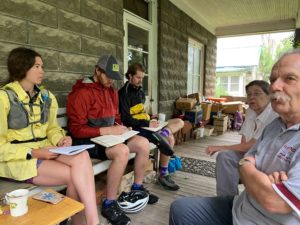 Sitting in a rodeo box in Augusta, Montana, I am reflecting on the juxtaposition of cultures we’ve experienced on our ride across Montana so far. This morning we spoke with Hal Herring, an avid hunter and environmentalist with a deep Alabama drawl. Along the way we’ve met activists whose chosen method of communication is theater, and coal miners who work hard to supply the fuel that still powers much of our country. From each of these people, and many more, I have realized they have very different lives – ranchers, miners, public health advocates – and different relationships with energy and the environment. To learn about these relationships, we entered into conversations with them. I could explain the gist of those conversations here, but that would not do them justice. Instead, I want to encourage everyone to seek this kind of conversation in their own lives.
Sitting in a rodeo box in Augusta, Montana, I am reflecting on the juxtaposition of cultures we’ve experienced on our ride across Montana so far. This morning we spoke with Hal Herring, an avid hunter and environmentalist with a deep Alabama drawl. Along the way we’ve met activists whose chosen method of communication is theater, and coal miners who work hard to supply the fuel that still powers much of our country. From each of these people, and many more, I have realized they have very different lives – ranchers, miners, public health advocates – and different relationships with energy and the environment. To learn about these relationships, we entered into conversations with them. I could explain the gist of those conversations here, but that would not do them justice. Instead, I want to encourage everyone to seek this kind of conversation in their own lives.
Thinking back to my first semester of college, it was all too easy for me to judge someone’s values by their choice of footwear – are they a vegan, Chaco-wearing hippy? Or a cowboy boot-wearing redneck? The people I’ve met on our ride have challenged my tendency towards knee-jerk judgment, and this brings up valuable questions for me: How do we bring seemingly different cultures together for a common cause? How do we bring about a culture shift in America that encourages both cooperation and movement towards a more sustainable future?
Earlier today, we met Anne Carlson. Anne is a scientist who works with The Wilderness Society. After a career in wildlife biology, she shifted her focus towards her community, and now works to convey data in a manageable way. She believes relationships are the key to finding solutions for the climate crisis, and the essential step to building those relationships is listening. She is actively seeking out people and conversations that are seldom heard, in an effort to bring new ideas and fresh perspectives to the climate conversation.
Two examples she said she is currently listening to are the Iinnii Initiative, and the history of the Métis people. The Iinnii Initiative was started by the Blackfoot Confederacy to reintroduce buffalo to the landscape in order to restore and sustain Native culture. The Métis, descendants of French trappers and Native Americans, have a rich history in Montana, but are widely spread across the landscape and so hard to join in conversation. Anne is looking to learn from people and projects like these and to join them in discussions about how Native people survived past climate disruptions.
Her efforts show the need to expand the reach of the conversations we have. As we have seen, common threads may exist where we don’t expect them. College students could benefit from following in Anne’s footsteps. Rather than dismiss others we believe to be different, we can open the door for conversation and might find that we have more in common than we expected.
I realize that to many this may seem like a naive and idealistic hope – that the possibility of bridging gaps between cultures may not resonate with you. And that worries me. It matters to me that you feel the value of connection as I have felt it these past few weeks. But I think at this point, to explain my own feelings any further would let the meaning slip away. The point is that we need to find our own reasons for connecting with the communities we care about, those we don’t agree with, and those we haven’t even imagined yet. Rather than talking past people we don’t understand, we ought to be listening to them, and talking with them.